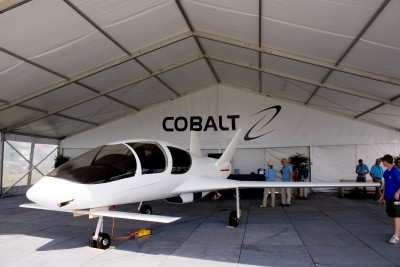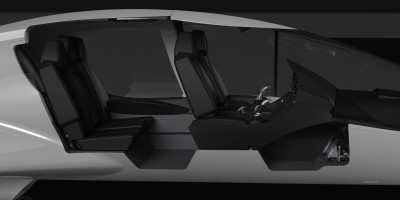Wed, Jul 28, 2010
A New French Entry Into The Single-Engine 4-Place Business
Arena
By Geoff Sobering
Cobalt Aircraft of Toussus-leNoble, France brought their
prototype Co50 aircraft to AirVenture. The Co50 is a single-engine,
canard, airplane targeted at the US business market. The Co50's
planned $650k price places is solidly in the same niche as the
SR-22 Turbo, DA-50, and similar aircraft. The Co50 has 4+1 seating,
accommodating four adults with the rear-seat center arm-rest usable
for a child. The cockpit has side-sticks and a single-lever FADEC
throttle with a mechanically programmed propeller linkage with a
"best power" and "best economy" selector. Power is provided by a
twin-turbocharged TCM TSIOF-550-D2B producing 350 hp, driving a
Hartzell three-blade aluminum propeller. Cruise speed at 75% power
is expected to be 220 kn, with a best-efficiency cruise of 202 kn
at 55% power. Maximum range is predicted to be 1150nm with a
ceiling of FL250.

Cobalt Prototype
The first flight of the prototype is scheduled to start in the
late fall of this year, with certification starting by the end of
2010. The Co50 will be initially certified with the FAA, but it has
been designed to meet EASA requirements for European certification
in the future. FAA certification is expected to take two years,
with a first customer delivery in about two and one-half years.
Marcellette Cloche, of the Cobalt marketing department, emphasized
that their business model is not predicated on large number of
initial orders or sales. She went on to say that Cobalt is not at
AirVenture looking for orders, but mostly to raise awareness of the
airplane in the GA community. Cobalt is also looking for US
distributors. Production will be in the US, although the plant
location has not been determined.

3+1 Seating Configuration
The structure of the Co50 is different that the typical
stressed-skin monocoque structure. A spine of carbon-fiber and
structural-foam takes the main loads from the wing spar, rudders,
and engine. The fuselage is therefore a much lighter fiberglass
structure with only one ring-frame aft of the doors and bulkhead
behind the cabin. This design contributes to the 1874 lb empty
weight, and the 1213 lb useful load. Instead of the usual
wing-tanks, all the fuel is carried in one tank below the cargo
area. This simplifies both the wing structure as well as plumbing
and fuel management.
FMI: www.cobalt-aircraft.com
More News
States That Current Process is Damaging National Aerospace Development US Senator Jerry Morgan is pushing the FAA to speed up the process for rocket launch licensing. He argues tha>[...]
From 2015 (YouTube Edition): Model Aviator Aims For Full-Scale Career While at the 2015 Indoor Electric RC Festival, referred to as eFest, ANN CEO and Editor-In-Chief, Jim Campbell>[...]
Dave Juwel's Aviation Marketing Stories ITBOA BNITBOB ... what does that mean? It's not gibberish, it's a lengthy acronym for "In The Business Of Aviation ... But Not In The Busine>[...]
Aero Linx: Cardinal Flyers Online The Cardinal Flyers Online Web site was created and is maintained by me, Keith Peterson. My wife Debbie and I have owned a 1976 RG since 1985. Wit>[...]
Clearance Void If Not Off By (Time) Used by ATC to advise an aircraft that the departure release is automatically canceled if takeoff is not made prior to a specified time. The exp>[...]
 Senator Pushes FAA to Accelerate Rocket Launch Licensing
Senator Pushes FAA to Accelerate Rocket Launch Licensing Classic Aero-TV: RJ Gritter - Part of Aviations Bright New Future
Classic Aero-TV: RJ Gritter - Part of Aviations Bright New Future Aero-FAQ: Dave Juwel's Aviation Marketing Stories -- ITBOA BNITBOB
Aero-FAQ: Dave Juwel's Aviation Marketing Stories -- ITBOA BNITBOB ANN's Daily Aero-Linx (10.27.24)
ANN's Daily Aero-Linx (10.27.24) ANN's Daily Aero-Term (10.27.24): Clearance Void If Not Off By (Time)
ANN's Daily Aero-Term (10.27.24): Clearance Void If Not Off By (Time)




